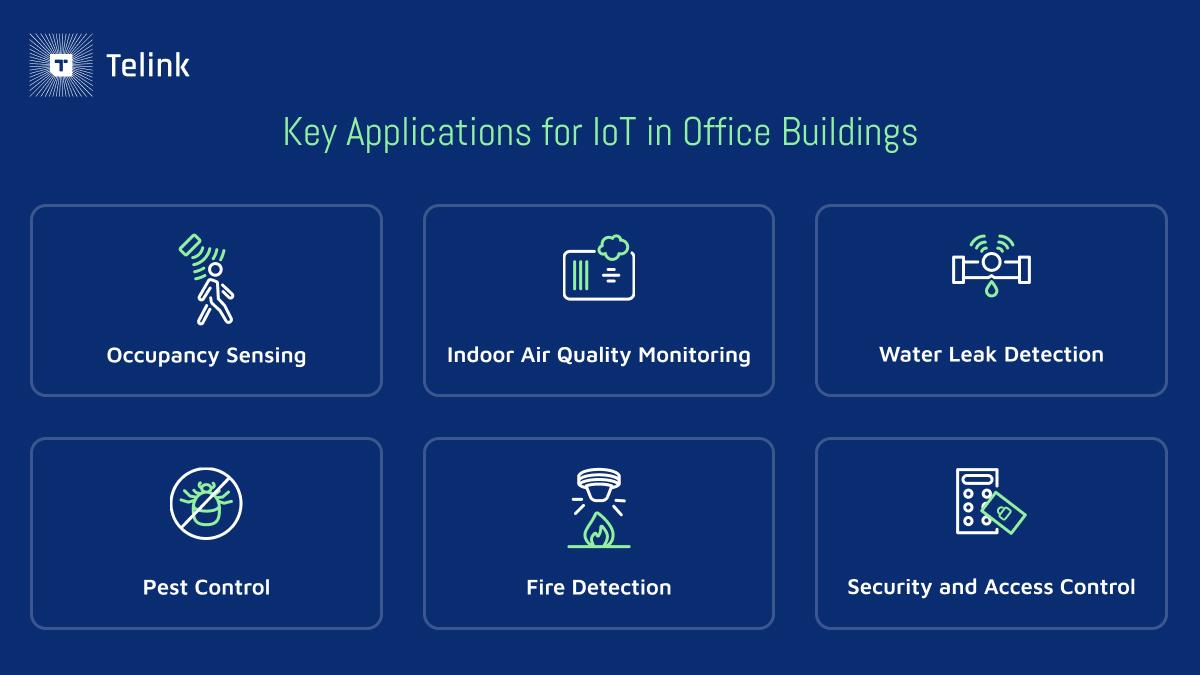


旋转设备


Telink Staff
July 22, 2024

See how smart office technology is improving productivity and employee well-being to transform workplaces.
Office work doesn’t look the same as it did five years ago. In fact, smart office technology is quickly redefining how people fulfill their daily responsibilities. The rise of fully remote and hybrid work schedules has created a need for more dynamic workspaces that better align with employee lifestyles and accommodations. For those who head into the office regularly throughout the week, there has also been a growing emphasis on employee well-being, with companies recognizing the importance of optimal environmental conditions—such as air quality, temperature, and lighting—in enhancing productivity and comfort.
But today’s offices don’t only benefit consumers. As more and more organizations dive into the world of IoT, developers have new opportunities to create devices that fit the growing needs and applications of workspaces worldwide. For example, the desire of businesses to lower maintenance costs opens up an avenue for developers to design innovative IoT devices that help prevent water leaks, monitor machine performance, and proactively address other issues that can cost money. As more devices become interconnected and cross-functional, developers can leverage these workplace shifts to gain a competitive edge with unique IoT solutions that help companies thrive and evolve alongside consumers.

Office buildings are more than just cubicles and meeting rooms; they’re where talent and creative minds converge to make things happen. For any business to be successful, employees have to feel supported, comfortable, and equipped with the resources they need to be effective in their roles. IoT office solutions and smart office technology help make this possible—here’s how:
One of the most impactful applications of IoT in office buildings is occupancy sensing. By deploying smart AI cameras and radar devices, for example, office managers can monitor and manage spaces more effectively, reducing operating costs and ensuring compliance with maximum capacity regulations. Additionally, it enables the efficient booking of meeting rooms, making the overall workspace more efficient and responsive to the needs of its users.
Keeping employees healthy is essential for optimal operational performance. IoT office solutions like smart sensors and cloud analytics can help monitor and control air quality variables, such as temperature, humidity, and the presence of harmful gases and particulate matter. These systems ensure that the office environment remains conducive to health by constantly maintaining ideal conditions.
Smart office technology like flow meters and water sensors can detect flow, velocity, or pressure changes within plumbing networks, providing early warnings of potential leaks. As a result, office managers can prevent water waste and minimize the risk of extensive damage that can cost money and disrupt workflows.
Pest control is another area where IoT office technology can make a significant difference. Using sensors and smart traps, office managers can monitor and manage pest activity more effectively. These systems can repel and exterminate bugs that might otherwise transmit germs and diseases to keep offices clean.
Smart sensors can also detect potential fires by identifying risks and malfunctions that pose fire hazards. In this way, occupants, property owners, emergency services, and local authorities can respond quickly before a dangerous situation can escalate. Rapid alerts can make all the difference in keeping everyone safe and protecting valuable assets.
By integrating a mixture of sensors and secure access protocols like Aliro, building administrators can monitor and control who enters the premises and when. Developed as a collaboration between over 200 tech companies, Aliro offers a standardized way for users to access secure buildings via smartphones and wearables. Developers can consider integrating protocols like Aliro to help businesses better secure assets and grant access to only authorized personnel.
Not all IoT devices are created the same, but they should at least have these key features to keep up with current consumer demands and business requirements:
With these core characteristics, developers can craft IoT office technologies that evolve and adapt to changing business environments with ease.
At Telink, we understand that if technology isn’t designed for the future, it’s already falling behind. That’s why we offer an array of SoCs and software development kits to help you develop the next generation of IoT products and stay on top of the industry. For remote control, smart lighting, and automation solutions, try our TLSR921x and TLSR825x chip series for compatibility with protocols designed to handle the complex networks of office buildings, such as Thread, Bluetooth Mesh, Zigbee, and Matter. For dongles and other human interface devices, consider our TLSR835x series for proprietary features that can keep employees connected to the work appliances they need. Whatever you need, Telink has the solutions to propel your products forward.
Visit Telink’s wiki to learn more about our development tools, ask us a question through our Technical Forum, or contact us directly today.